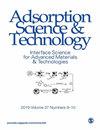Economic TEHES-Tube Material Evaluation by Absorbability Index under O-S-Dimensions for Minimizing Global Warming and Air Pollution by Exploring Dominance Theory: Green Management Initiative
IF 2.8
4区 工程技术
Q2 CHEMISTRY, APPLIED
引用次数: 0
Abstract
It is investigated that the Global Warming and Air Pollution (GWAP) issues are highly prioritized around the world. There is a high magnitude of contaminated hot heat (CHH) from hot fluids such as contaminated water, oils, and mixed oils; toxic oils increase the GWAP ON emission. Such GWAP can be controlled by applying the methods-techniques for optimizing the energy processes, evaluating the high energy absorption material among available materials and technological advancement in energy flow devices, optimizing design of energy systems and low heat emission strategy, etc. It is observed that nowadays, Thermal Energy Heat Exchanger Systems (TEHESs) are utilized in many industries for transferring the energy between two mineral or contaminated liquids, separated by walls. It is found that TEHESs are constructed by tube materials, might be contributed to control the GWAP if TEHESs are fabricated with composite material, and have a high absorbability index. The evaluation of the Energy Absorbability Index (EAI) of TEHES composite tube materials provides the two innovative solutions to TEHES designers such as choose the economic/cost TEHESs and initiate to green management (reducing minimizing the GWAP). On literature survey, a few research documents are found by authors, which focused on mathematical modelling of either O- (objective-) or S- (subjective-) dimensions of composite TEHES tube material evaluation models for computing EAI. It is also probed that those models are simulated by single or nondynamic material evaluation methods. Therefore, it is summarized that there are no still research document pertaining to integrated/mixed mathematical modelling of O-S- (objective-subjective-) dimensions of composite TEHES tube materials with dominance theory for computing EAI of composite TEHES tube materials. Said research gaps are respected as major research defies (help to minimize the GWAP or green management). To fulfil the said research defies, the authors developed and proposed the TEHES-O-S-composite tube material evaluation model by conducting literature and real industrial survey, consisting of seven TEHES-O and four TEHES-S tube material dimensions. The O-dimensions are framed by available O-rating/data, while S-dimension is framed S-rating. The TFNs (triangular fuzzy numbers) are used by a team of experts for assigning the appropriateness ratings vs. four TEHES-S composite tube material dimension, and priority weights are assigned vs. entire TEHES-O-S tube material dimensions. After data modelling of the TEHES-O-S-composite tube material evaluation model, defuzzification is carried out to normalize O-S-data. Later, the authors’ implemented integrated optimization technique “crisp VIKOR combined FMF technique” to evaluate the EAI of composite TEHES tube materials. As the reliability of results is an enormous concern, dominance theory is applied by conducting the comparative analysis among evaluated results and delivering the accurate and reliable results. The evaluated beast composite TEHES tube materials based on EAI linked to green management and economic concern of material. The research can be used by TEHES designers to minimize the GWAP across the universe.利用o - s维度下的可吸收性指数对经济teses管材料进行评价——探索优势理论:绿色管理倡议:减少全球变暖和空气污染
研究表明,全球变暖和空气污染(GWAP)问题在世界范围内受到高度重视。来自热流体(如受污染的水、油和混合油)的污染热(CHH)强度很高;有毒油增加了GWAP ON的排放。可通过优化能量过程、在可用材料中评估高能量吸收材料和能量流装置的技术进步、优化能源系统设计和低热辐射策略等方法技术来控制这种GWAP。据观察,如今,热能热交换器系统(TEHESs)在许多工业中用于在两种矿物或受污染的液体之间传递能量,由墙壁隔开。研究发现,采用管状材料构成的微微管具有较高的吸波系数,复合材料制备微微管有助于控制GWAP。通过对TEHES复合管材料的能量吸收指数(EAI)的评估,为TEHES设计者提供了选择经济/成本的能量吸收指数和启动绿色管理(最大限度地降低GWAP)两种创新的解决方案。在文献综述中,笔者找到了一些研究文献,这些文献主要集中在0 -(客观)或S-(主观)维度的复合TEHES管材料评价模型的数学建模上,用于计算EAI。还探讨了用单一或非动态材料评价方法来模拟这些模型。综上所述,目前还没有基于优势理论对复合TEHES管材料的O-S-(客观-主观)尺寸进行综合/混合数学建模的研究文献,用于计算复合TEHES管材料的EAI。上述研究差距被视为主要研究缺陷(有助于最小化GWAP或绿色管理)。为了满足上述研究缺陷,作者通过文献和实际工业调查,开发并提出了由7个TEHES-O和4个TEHES-S管材料维度组成的TEHES-O- s复合管材料评价模型。o维由可用的o级/数据构成,而s维则由s级构成。专家团队使用tfn(三角模糊数)来分配相对于四个TEHES-S复合管材料尺寸的适当性评级,并针对整个TEHES-O-S管材料尺寸分配优先级权重。在对tehes - o - s复合管材料评价模型进行数据建模后,对o - s数据进行去模糊化归一化处理。随后,作者实施了集成优化技术“脆VIKOR结合FMF技术”来评估复合TEHES管材料的EAI。由于结果的可靠性是一个非常重要的问题,所以运用优势理论,对评估结果进行对比分析,给出准确可靠的结果。评价了基于EAI的复合材料TEHES管材料的绿色管理和材料的经济性问题。这项研究可以被TEHES设计者用来最小化整个宇宙的GWAP。
本文章由计算机程序翻译,如有差异,请以英文原文为准。
求助全文
约1分钟内获得全文
求助全文
来源期刊

Adsorption Science & Technology
工程技术-工程:化工
CiteScore
5.00
自引率
10.30%
发文量
181
审稿时长
4.5 months
期刊介绍:
Adsorption Science & Technology is a peer-reviewed, open access journal devoted to studies of adsorption and desorption phenomena, which publishes original research papers and critical review articles, with occasional special issues relating to particular topics and symposia.
 求助内容:
求助内容: 应助结果提醒方式:
应助结果提醒方式:


